
Antigua, Guatemala cover page. |

Map of Guatemala with the star indicating Antigua. |
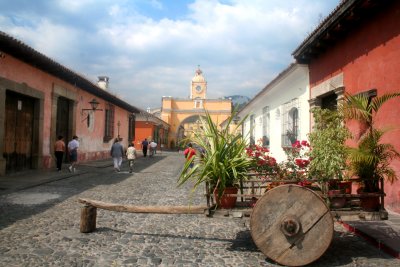
View of the Arch of Santa Catalina, which spans Calle del Arco. |

Built in the early 17th century, the arch was part of the Santa Catalina Monastery. |
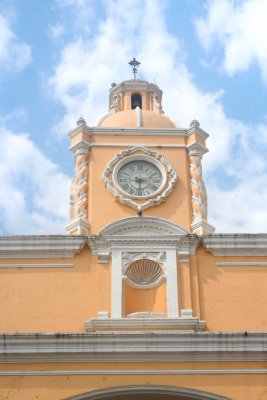
Clock tower of the Arch of Santa Catalina. |

I was walking north on Calle del Arco when a man carrying a heavy load walked towards me. |
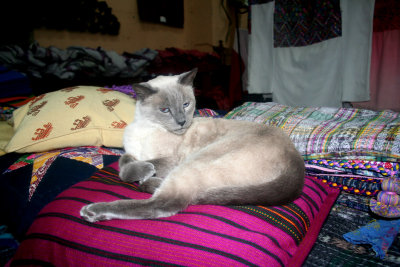
I stopped in a souvenir shop on Calle del Arco and met this handsome feline who was napping on some Guatemalan fabrics. |
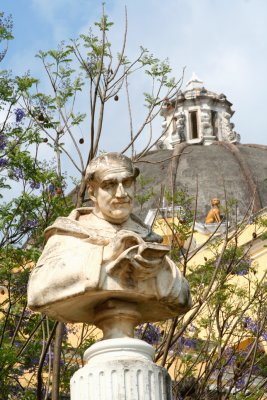
Bartoleme de las Casas (1484-1566), a Spanish Dominican priest was partly responsible for the repeal of Indian slave labor laws. |
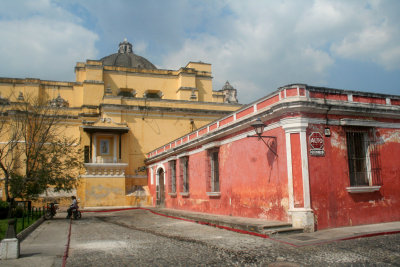
Side view of the Iglesia y Convento de Nuestra Señora de La Merced, Antigua’s most striking colonial church. |
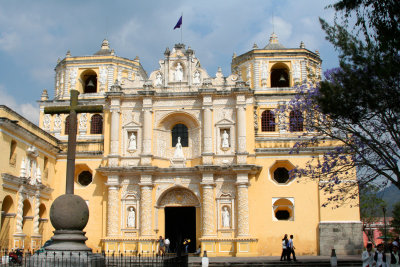
In 1773, an earthquake struck, and the convent was destroyed. Repairs to the church were made from 1850 to 1855. |

The baroque façade of La Merced dates from this 1850 to 1855 period. |
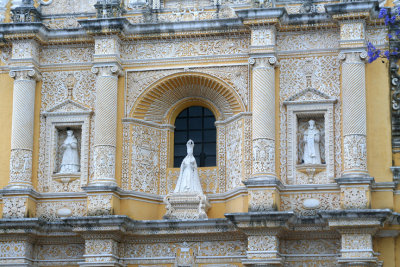
View of the exquisite upper façade of La Merced, the most intricately decorated façade in all of Antigua. |

Detail of a beautiful doorway of La Merced. |
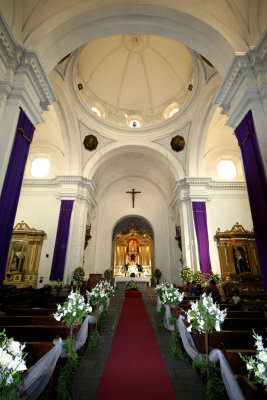
View of the interior of La Merced with a domed ceiling. |
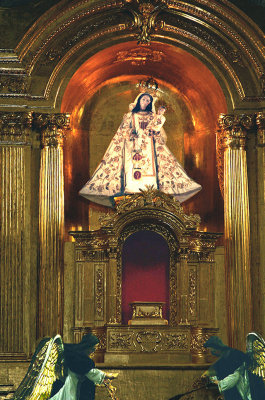
Close-up showing the altar. |

Worshippers praying in front of a side altar inside of La Merced. |
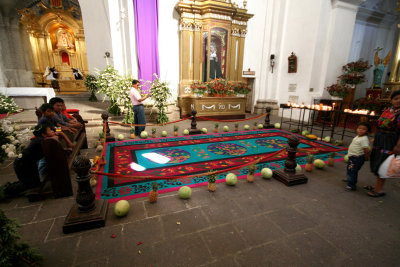
A beautiful Guatemalan carpet on display for the Lent season in front of the worshippers. |
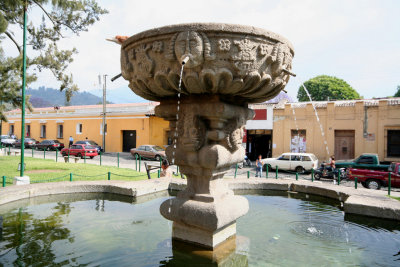
Nice fountain that is next to La Merced. |
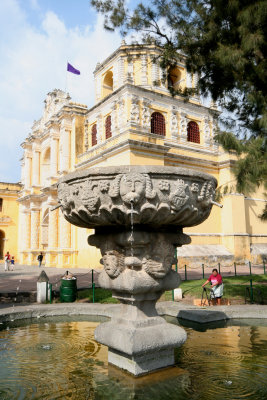
View of the fountain with La Merced in the background. |

Verdant passageway inside Casa Santo Domingo convent. This colonial-era convent housed the order of Santo Domingo de Guzmán. |
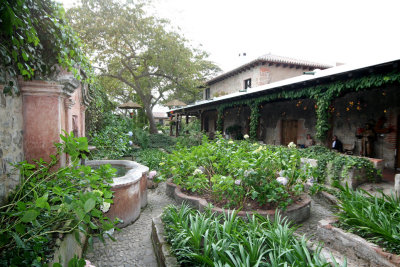
Some gardens inside the convent which is now a hotel. |
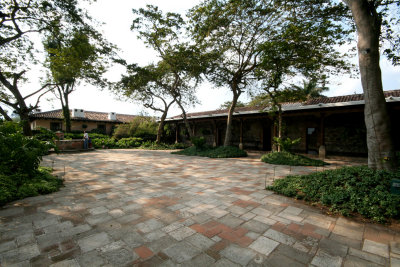
Nice tile walkway with buildings in the background. |
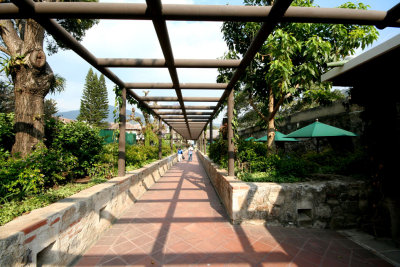
Passageway with interesting perspective. |
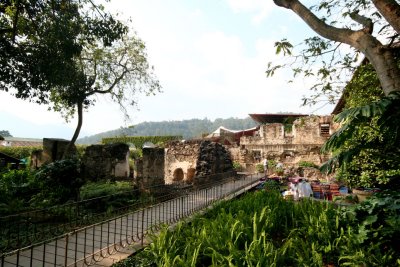
Walkway leading to some ruined buildings of the Casa Santo Domingo convent. |
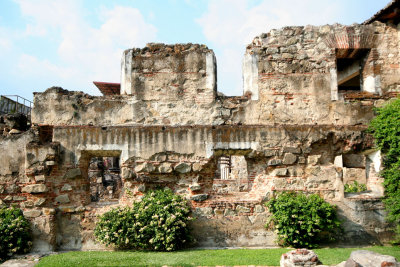
A dilapidated wall which was formerly part of the convent. |
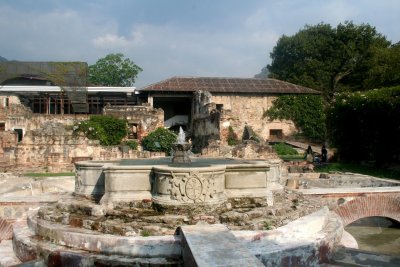
A nice fountain among the Casa Santo Domingo convent ruins. |

Vendors camped out in front of the ruins of the Church of el Carmen. |
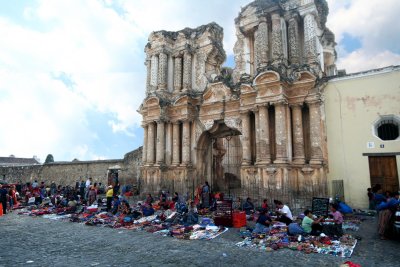
Remains of the ornate baroque façade of the Church of El Carmen which was completed in 1728. |
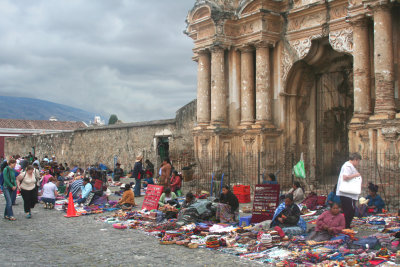
This market is a bargainer's paradise. |

Tourist going by El Carmen in a horse and buggy. |
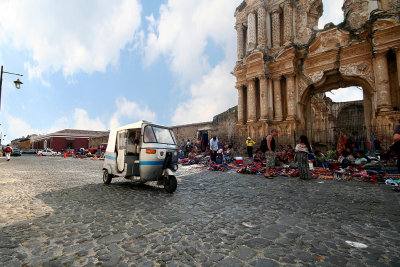
Ruins of the Church of el Carmen with a typical Guatemalan 3-wheeled taxi going by. |
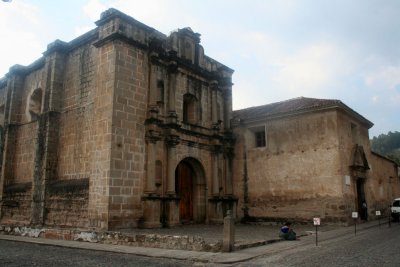
Side view of the Church of Capuchinas which is connected to the convent and was completed in 1736. |

Façade of the Church of Capuchinas. |

Interior of the Church of Capuchinas. |

Interior courtyard and fountain in the Convent of Capuchinas, founded in 1736 by nuns from Madrid. |

Close-up of fountain. The nuns who lived in this convent were prohibited from having any visual contact with the outside world. |

A wide angle photo of City Hall. Construction began on it in 1740 by Diego de Porres, master architect of Antigua. |
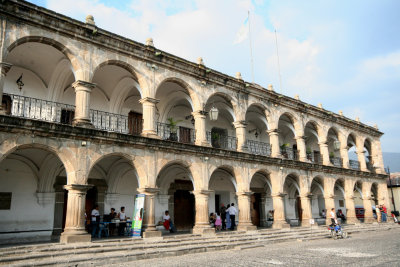
Today, it is the seat of the municipality of the city. Also, several museums are housed here. |
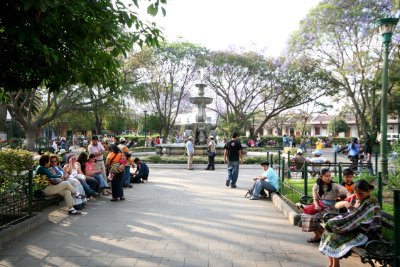
People enjoying the beautiful Parque Central in Antigua. |

People in front of a bird bath in Parque Central. |
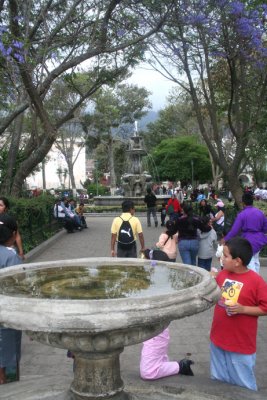
Close-up of the bird bath with the fountain in the background. |

View of the fountain that is in the middle of Parque Central. |

A closer view of the fountain. |
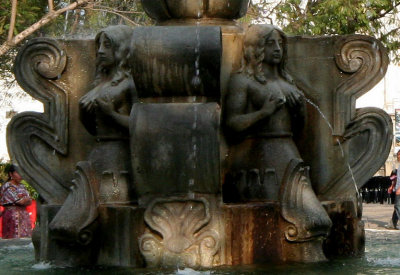
In this photo, you can see the fountain's risque mermaids! |
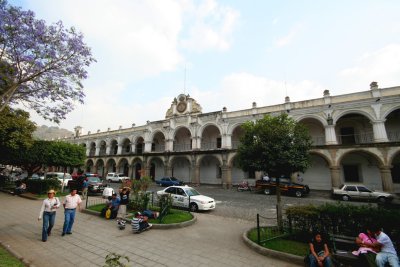
View from the south side of Antigua's Parque Central of the Palace of the Captains-General. |

The Palace of the Captains-General was, for more than two centuries, the seat of Spanish colonial government. |

While the two-tiered arched façade has been restored, the present palace is but a small remnant of the former complex. |
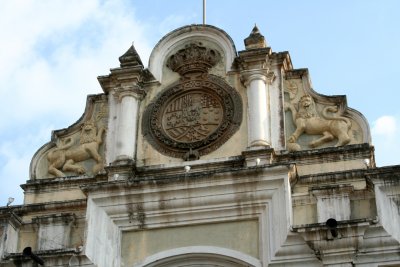
Details of the upper façade of the Palace of the Captains-General. |

I took a walk through the interior arched passageway of the Palace of the Captains-General. |

This is another passageway that goes along the merchant stores on the west side of Parque Central. |
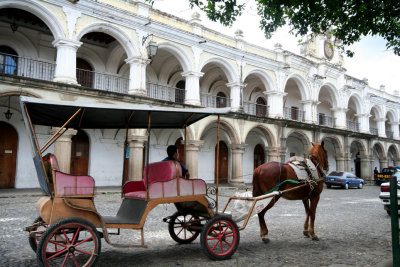
A quaint horse and buggy scene in front of the Palace of the Captains-General. |

Horse and buggy rides are popular with Antigua's tourists. |
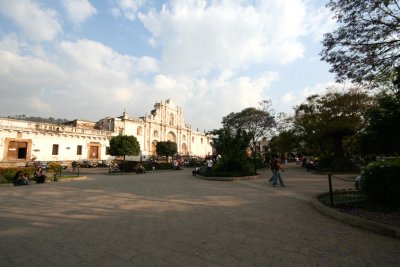
View in the background of the Cathedral of Santiago located on the east side of Antigua's Parque Central. |

It was started in 1542, damaged by several earthquakes and badly ruined in 1773. The current cathedral was rebuilt by 1820. |

Façade of the Cathedral of Santiago. While impressive, it lacks the former grandeur of the original cathedral. |

Details of the upper façade of the cathedral. |

Close-up of religious carvings on the upper façade. |
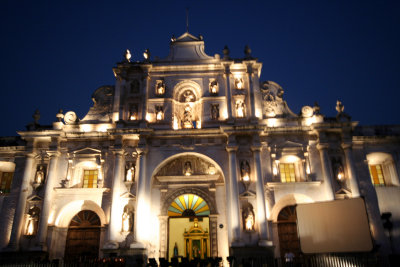
I took this photo of the Cathedral of Santiago at night. |

A wedding took place place at the cathedral. The bride was standing with the groom behind her. |
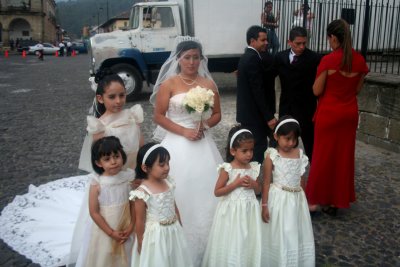
The bride with some of the younger members of the wedding party. |
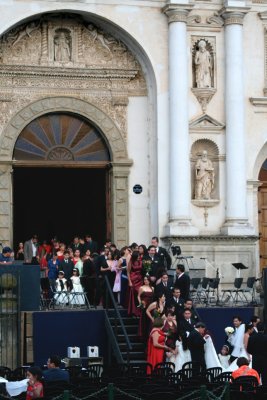
People leaving the cathedral after the wedding was over. |

Interior view of the altar of the Cathedral of Santiago. |
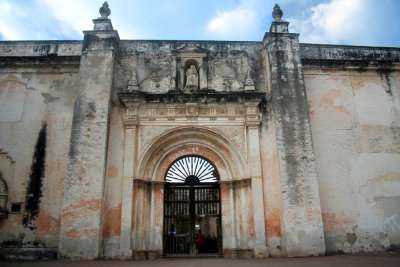
Side entrance to the Cathedral of Santiago. |
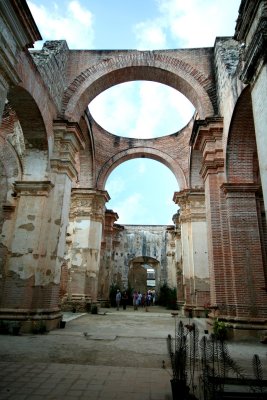
The cathedral was largely ruined the earthquake of 1773. Except for the front, much of the cathedral is still ruined. |
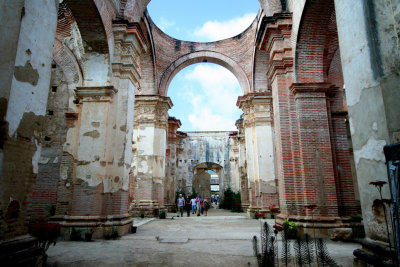
These open areas were once beautiful domes. |

Much of the cathedral is skeletal, without a roof and pillars. |

Despite the ruined condition, there are still details showing the beautiful colonial architecture. |
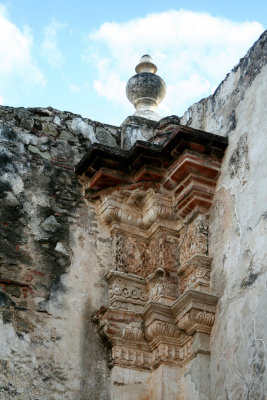
More intricate carvings at the top of the cathedral's columns. |
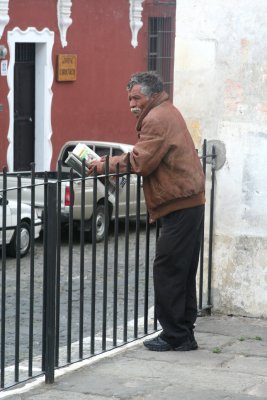
This man was reading the paper in front of the Cathedral of Santiago. |
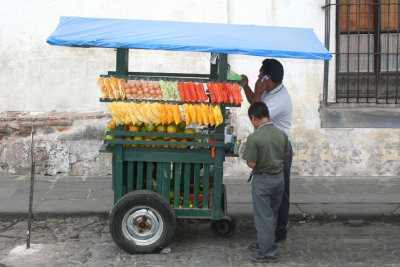
A street vendor was selling fruit nearby. |
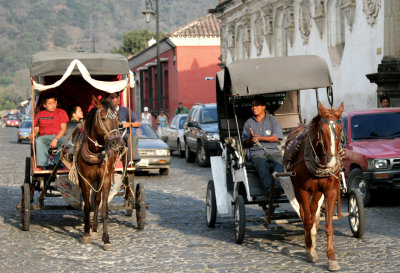
It looked like there was a buggy race in front of the cathedral. |

Architectual details above the Colonial Museum which is across from the Cathedral of Santiago on 5a Ca Oriente (street). |
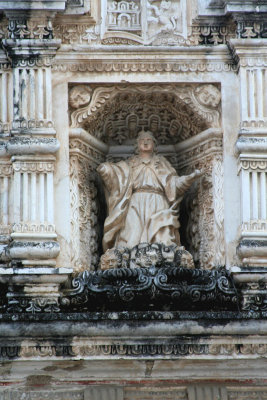
The Colonial Museum was formerly the University of San Carlos which was founded in 1675. |
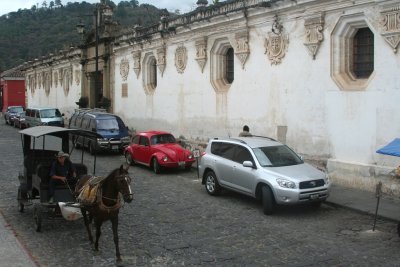
Horse and buggy passing on 5a Ca Oriente in front of the Colonial Museum. |
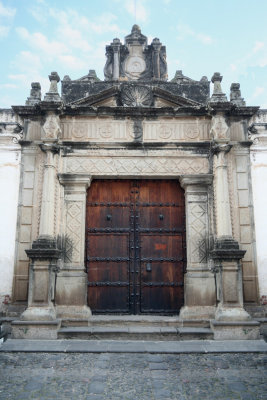
The wooden doors of the entrance to the Colonial Museum. |
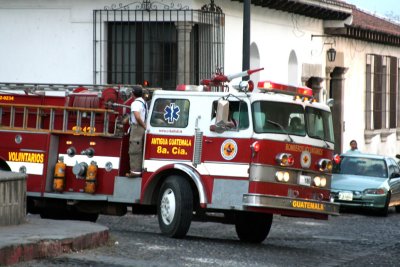
As I was turning the corner onto 2a Avenida Sur, this firetruck went speeding by. |
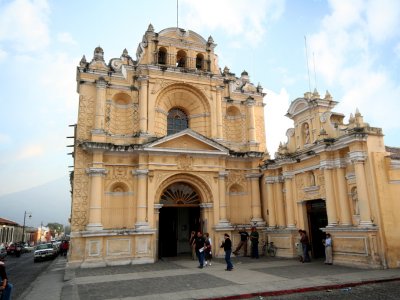
The Church of Hermano Pedro and the adjacent Hospital of San Pedro. |

Both are named after the 17th century Spanish-born Franciscan monk Hermano Pedro de San José Betancourt. |
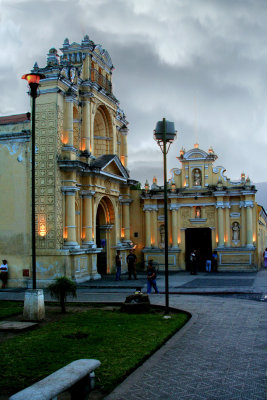
I also took a photo of the Church of Hermano Pedro and the adjacent Hospital of San Pedro at dusk. |
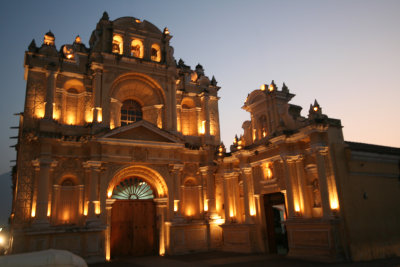
I took this photo of the Church of Hermano Pedro at night. |

View of Union Park which is next to the Church of Hermano Pedro and the adjacent Hospital of San Pedro. |

A monument in the park "symbolizing the encounter of the two sides of the sea" (Spain and Guatemala). |

At the other end of the park are the ruins of the Santa Clara church and convent and this pool with arches. |

I was intrigued by the reflection of the arches in the water. |
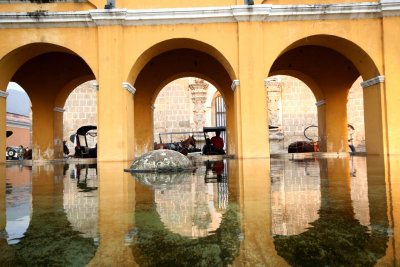
The water was like a mirror image. |

Through this arch was a horse and buggy and driver. |
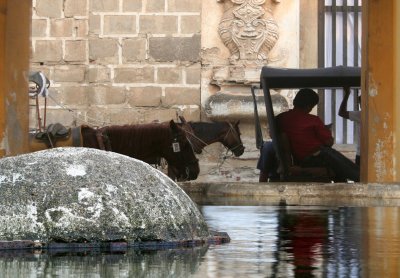
Close-up of the horse and buggy and driver and the driver's reflection. |
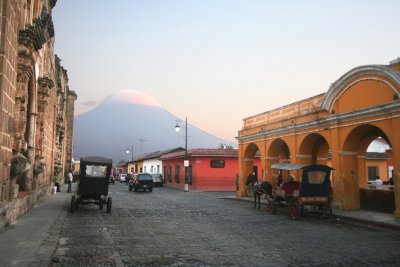
View of the arches where the horse and buggy and driver were. Note the Volcán de Agua (mountain) in the background. |

Photo of the rear of the pool and arches at dusk. |
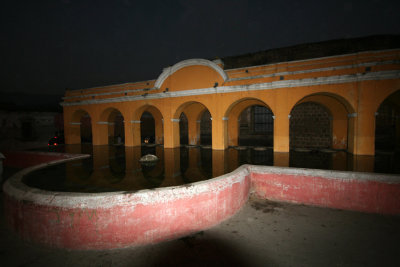
The front of the pool and arches at night. |
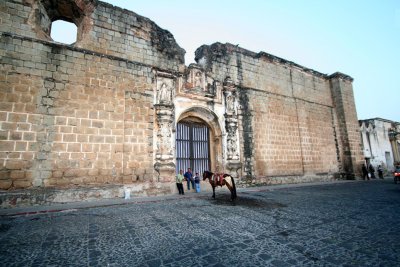
Wall and doorway of the ruins of Santa Clara church and convent. Six nuns founded the convent in 1699. |
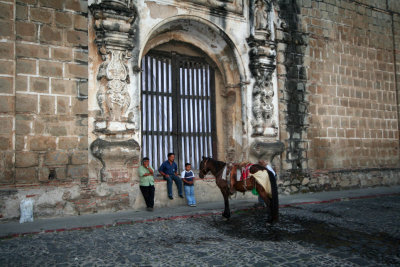
It was destroyed by an earthquake in 1717. The present building was built in 1734 and destroyed in another earthquake in 1773. |
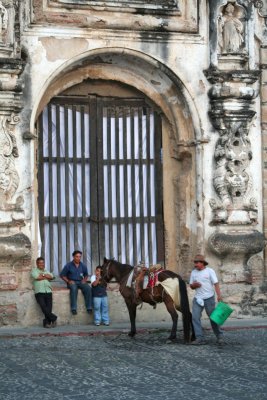
Some Guatemalan people and this horse were in front of Santa Clara. |
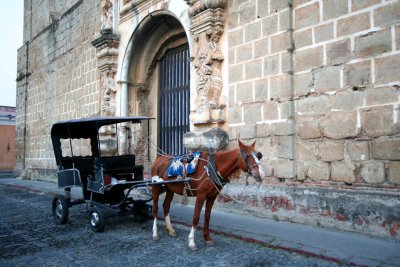
This horse and buggy were also in front of Santa Clara. |

Further down Santa Clara on 1 a Av Sur was this building with an ornate entrance. |

This is the corner wall of San Francisco Church, the most important religious center in Guatemala. |
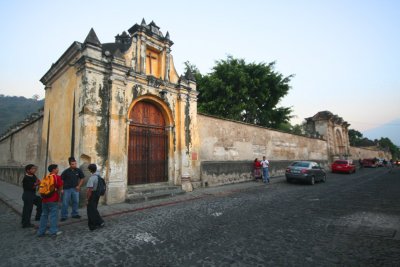
This view of the corner wall was taken with a wide-angle lens. |
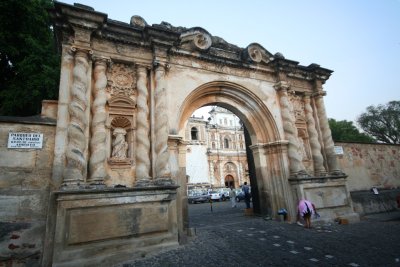
Arched entrance of San Francisco Church. |
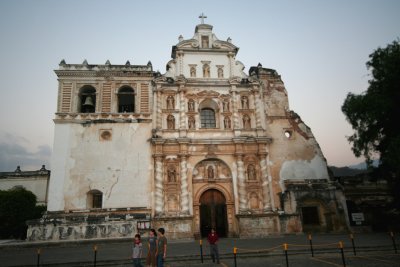
The original structure is from 1579. The church remains, but the adjacent convent was destroyed in the earthquake of 1773. |
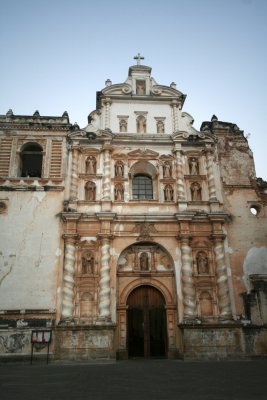
Pilgrims come to San Francisco to ask favors to Beatro Pedro de Betancourt (Spanish-born Franciscan monk who was made a saint). |

Ornate interior and arched ceiling of San Francisco Church. |

View of the upper façade of the church. |
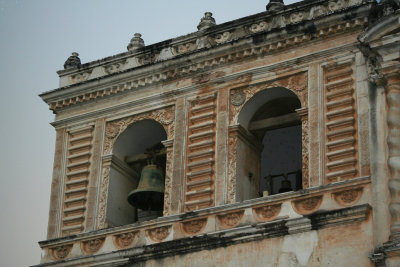
The bell tower of San Francisco Church. |

The top of the church adorned with statues of saints and a cross. |

The cloister of the Hispanic-moorish style University of San Carlos (today, the Museum of Colonial Art) built in 1676. |
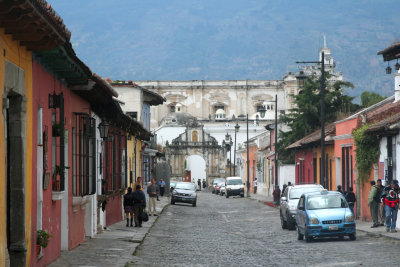
More streets scenes with a church in the background. |
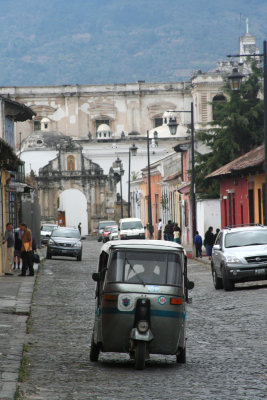
This 3-wheeled taxi was coming my way. They are usually red and are a common sight in Guatemala. |
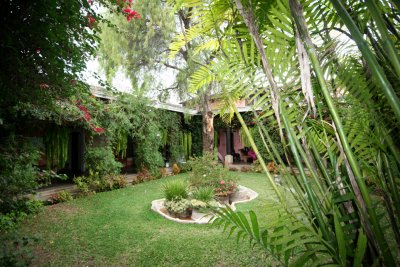
I took a tour of Antigua, and was taken to the El Meson De Candelaria Hotel with a courtyard. |
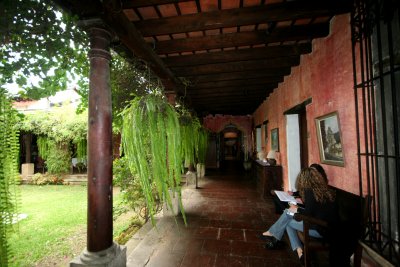
The hotel is located on Calle De Los Duelo. |

El Meson De Candelaria had some typical Guatemalan sculptures such as this one. |
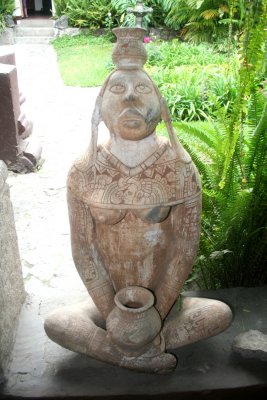
Another Guatemalan sculpture in the hotel. |
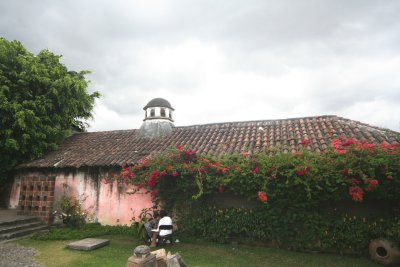
This is the back of the hotel with buganvilias growing on this tile-roofed building. |
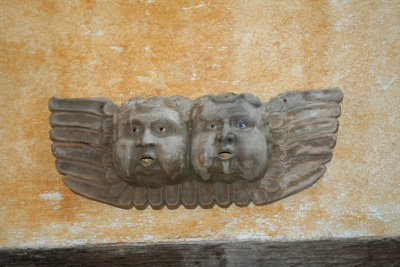
Nice Guatemala artifact on the hotel wall depicting angels. |
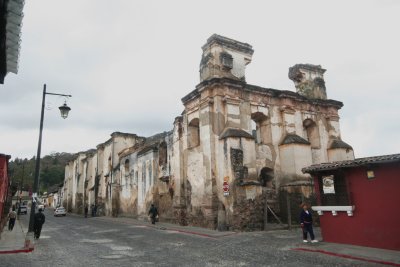
Another ruined building near the Jade Museum. |
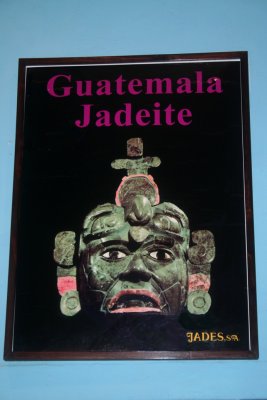
The guide took me to the Jade Factory and Museum, the largest jade operation in Central and South America. |
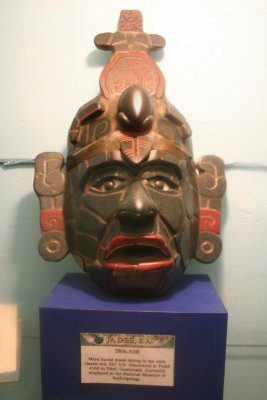
Replica of a Mayan burial mask (dated 527 AD) discovered in a tomb in Tikal. |
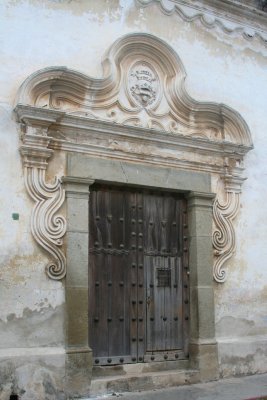
An impressive doorway in Antigua. |

A quiet street in Antigua. |

A typical white colonial house in Antigua. |
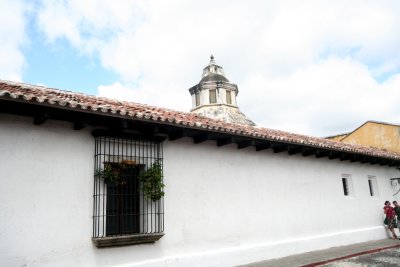
Another typical Antigua house. |
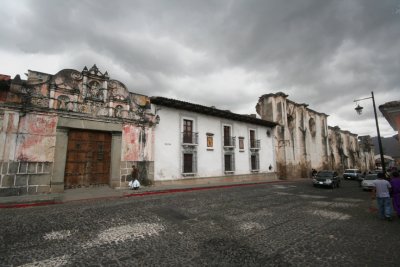
A great doorway on Calle de la Concepcion with a dramatic sky. |
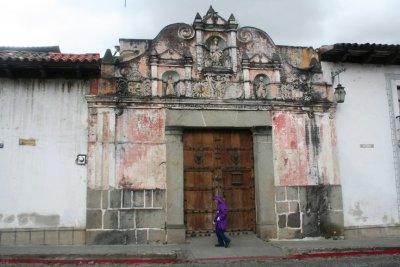
The man in the purple robe was part of the religious procession that took place that day. |

Close-up of the door. |
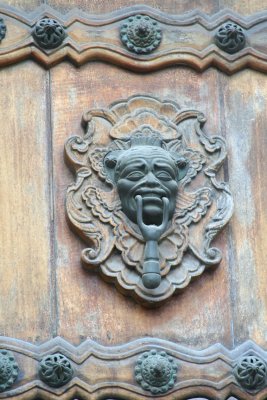
This fabulous door knocker was on the door. |

Beautiful tiled sign for Calle de la Concepcion. |
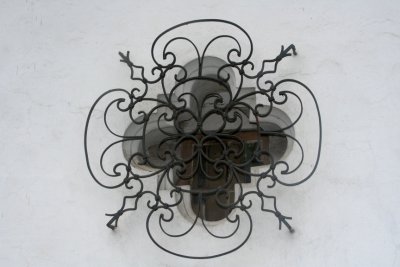
This wonderful ironwork covering this interesting window was also on Calle de la Concepcion. |

Street view of 4a Ca Poniente as I was walking west towards the Artisans' Market. |
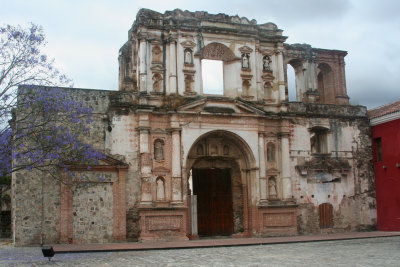
Ruins of the Compañía de Jesús built by the Jesuits in 1626. It was damaged in earthquakes. |
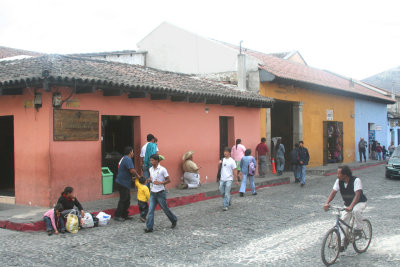
Street scene as I walked further west on 4a Ca Poniente. |

A blind and obese beggar that I saw while walking. |

Side view of St. Augustin monastery and church built by the Augustinians in the early 1600's. |

Construction took almost 50 years. The façade is rich with images of saints. |

Another ruin that I passed by in Antigua that had a purple flowering tree in the foreground. |

Front entrance of the convent of Santa Clara founded by nuns from Pueblo, Mexico in 1699. |
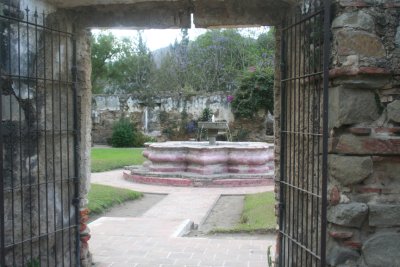
View of the fountain of Santa Clara through the entrance. |

The beautiful geometric fountain in the center of the courtyard has a flower-like shape. |
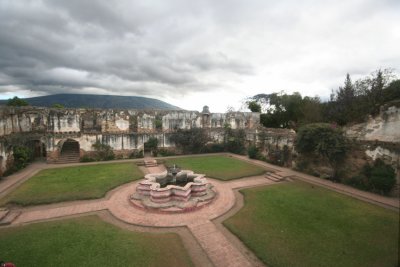
Santa Clara was badly damaged in the earthquake of 1717. After the earthquake of 1773, it was abandoned. |
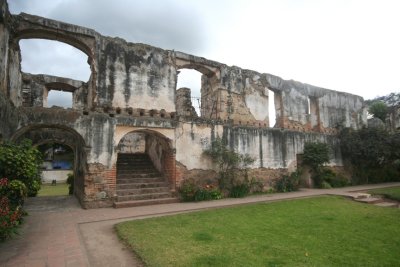
When it was functioning, Santa Clara had two levels housing 50 nuns. |
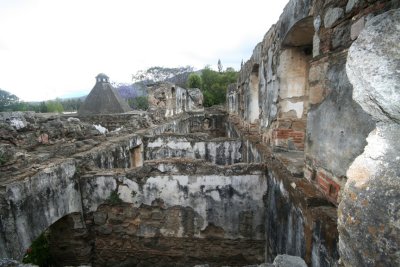
The outer south wall of Santa Clara shows how damaged it is. |

An even bigger ruin is the Iglesia y Convento de la Recolección (the church and monastery of la Recolección). |

The monks had a hard time getting permission to build this monastery. |
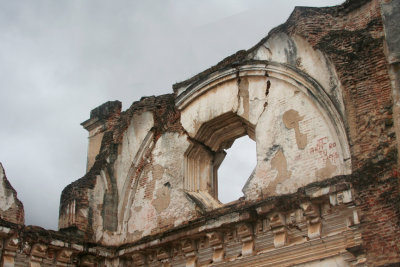
After getting permission, it was started in 1701 and inaugurated in 1715. |
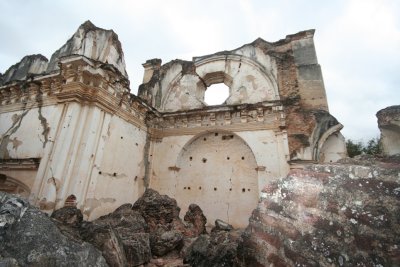
Two years later, it was destroyed by the earthquake of 1717. |
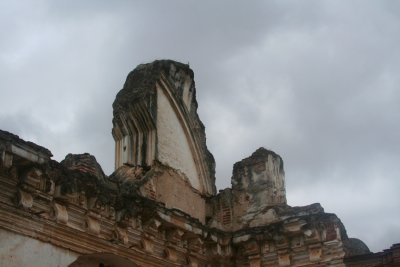
Later, it was restored, but in 1976, the famous arch that was still standing fell. |

La Recolección is the place to see large-scale ruins with huge chunks of walls and ceilings lying all over the place. |

It looks like the earthquake just happened yesterday, instead of in 1717! |
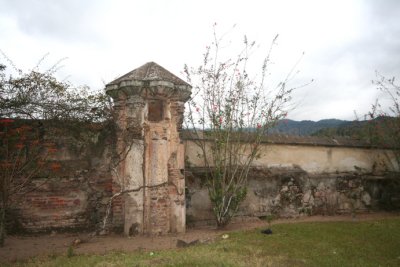
This wall with the tower goes along the north part of the front of the property where La Recolección is located. |

Antigua's brightly painted buses are called "chicken buses" because there is a good chance you may ride with one! |
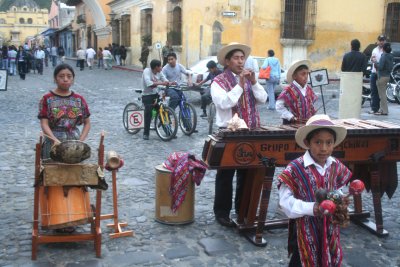
Outside of La Posada de Ron Rodrigo Hotel where I stayed on Calle del Arco, this Guatemalan band performed. |

This Guatemalan boy played the maracas. |











